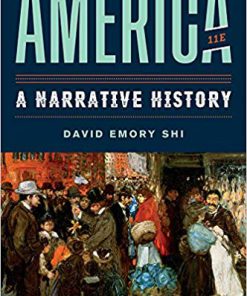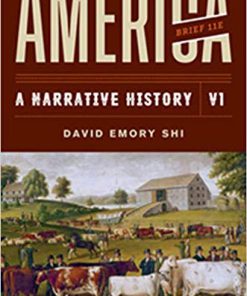Test Bank for US A Narrative History 8th Edition by Davidson
$35.00 Original price was: $35.00.$26.50Current price is: $26.50.
Test Bank for US A Narrative History 8th Edition by Davidson
Instant download Test Bank for US A Narrative History 8th Edition by Davidson pdf docx epub after payment.

Chapter 01
The First Civilizations of North America
Multiple Choice Questions
- Most modern archeologists would agree that the earliest inhabitants of the Western Hemisphere came from which of the following areas of the world?
A. Europe
B. South America
C.Asia
D. the Arctic
Answer: C
Bloom’s: Understand
Learning Objective: Explain the development of human settlement in the Americas and compare the key features of early Mesoamerican, South American, and North American societies.
Topic: Early Americans
- About 15,000 years ago BP, which land bridge was used by migrants to cross between Siberia and Alaska?
A.Bering Strait
B. Alaskan Strait
C. Siberian Strait
D. Straits of Asia
Answer: A
Bloom’s: Remember
Learning Objective: Explain the development of human settlement in the Americas and compare the key features of early Mesoamerican, South American, and North American societies.
Topic: Early Americans
- Which group was the first to build cities in the New World?
A. Aztecs
B.Olmecs
C. Toltecs
D. Mayas
Answer: B
Bloom’s: Remember
Learning Objective: Explain the development of human settlement in the Americas and compare the key features of early Mesoamerican,
South American, and North American societies.
Topic: Early Americans
4. Both the Mogollon and the Hohokam peoples of the American Southwest tended to build their dwellings near which of the following?
A. other villages
B. mountains
C. streams
D. sacred sites
Answer: C
Bloom’s: Understand
Learning Objective: Explain the development of human settlement in the Americas and compare the key features of early Mesoamerican, South American, and North American societies.
Topic: Early Americans
- Which of the following groups lived in what is now known as the Four Corners region of the United States?
A. Woodlands
B. Hohokam
C.Ancestral Pueblo
D. Aztecs
Answer: C
Bloom’s: Remember
Learning Objective: Explain the development of human settlement in the Americas and compare the key features of early Mesoamerican, South American, and North American societies.
Topic: Early Americans
- The Mogollon, the Hohokam, and the Ancestral Pueblo were North American cultures from which region of the United States?
A. Eastern Woodlands
B.Southwest
C. Great Plains
D. Great Basin
Answer: B
Bloom’s: Remember
Learning Objective: Explain the development of human settlement in the Americas and compare the key features of early Mesoamerican, South American, and North American societies.
Topic: Early Americans
- The Mississippian people were a culture from the
A.Eastern Woodlands.
B. Pacific Northwest.
C. Great Plains.
D. Great Basin.
Answer: A
Bloom’s: Remember
Learning Objective: Explain the development of human settlement in the Americas and compare the key features of early Mesoamerican, South American, and North American societies.
Topic: Early Americans
- The Numic-speaking peoples were from which geographic region?
A. Eastern Woodlands
B. Pacific Northwest
C. Great Plains
D.Great Basin
Answer: D
Bloom’s: Remember
Learning Objective: Explain the development of human settlement in the Americas and compare the key features of early Mesoamerican, South American, and North American societies.
Topic: Early Americans
- In which of the following areas did people live in a society with deep divisions among nobles, commoners, and slaves?
A. Subarctic
B.Pacific Northwest
C. Great Basin
D. Eastern Woodlands
Answer: B
Bloom’s: Remember
Learning Objective: Explain the development of human settlement in the Americas and compare the key features of early Mesoamerican, South American, and North American societies.
Topic: Early Americans
10. The inhabitants of which region moved from their summer fishing camps to berry patches in the fall, and into moose- and caribou-hunting groups in the winter?
A. Eastern Woodlands
B. Subarctic
C. Great Plains
D. Pacific Northwest
Answer: B
Bloom’s: Remember
Learning Objective: Explain the development of human settlement in the Americas and compare the key features of early Mesoamerican, South American, and North American societies.
Topic: Early Americans
11. What has proved to be the most important contribution of Native Americans to the course of human history?
A. the domestication of large animals
B. the deforestation of the Great Plains
C. the manipulation of plants for agriculture
D. the development of pottery and other stone works
Answer: C
Bloom’s: Understand
Learning Objective: Discuss the innovations and limitations that local resources provided early American civilizations.
Topic: Innovations and Limitations in the Americas
- What food, developed by Native Americans, forms the center of the contemporary American diet?
A.corn
B. teosinte
C. beans
D. squash
Answer: A
Bloom’s: Remember
Learning Objective: Discuss the innovations and limitations that local resources provided early American civilizations.
Topic: Innovations and Limitations in the Americas
- Which of the following was the most significant barrier to communication and technology transfer between groups in the Americas?
A. lack of interest among inhabitants
B. groups that did not know of each other’s existence
C. the perpetual state of war between groups
D.the north-south geography of the Americas
Answer: D
Bloom’s: Understand
Learning Objective: Discuss the innovations and limitations that local resources provided early American civilizations.
Topic: Innovations and Limitations in the Americas
- Why were Native Americans spared the effects of most of the world’s communicable diseases until contact with the Europeans in 1492?
A. Until that time, they had eaten a nutrient-rich diet.
B.Until that time, they had not domesticated any animals.
C. Until that time, they had not lived in large groups with close contact.
D. Until that time, they had rarely traveled out of their own communities.
Answer: B
Bloom’s: Understand
Learning Objective: Discuss the innovations and limitations that local resources provided early American civilizations.
Topic: Innovations and Limitations in the Americas
- Recently, scholars have begun to find evidence of incredible manipulations of landscapes and environments in the least likely of places:
A. the canyons of the Southwest.
B. the area now known as Mexico City.
C.the Amazon rainforest.
D. the Subarctic.
Answer: C
Bloom’s: Remember
Learning Objective: Discuss the innovations and limitations that local resources provided early American civilizations.
Topic: Innovations and Limitations in the Americas
- One of the major logistical obstacles that hindered New World agriculture and advancement in comparison to the Old World was
A. religion.
B. culture.
C.communication and technology.
D. illness.
Answer: C
Bloom’s: Understand
Learning Objective: Discuss the innovations and limitations that local resources provided early American civilizations.
Topic: Innovations and Limitations in the Americas
- Which of the following, built around 1300, contained more than 2,000 rooms and had a water and sewage-removal system?
A. Navajos
B. Ancestral Pueblo
C.Paquime
D. Pueblos
Answer: C
Bloom’s: Remember
Learning Objective: Outline the process of crisis and transformation that North American and Mesoamerican societies experienced between the twelfth and fourteenth centuries.
Topic: Crisis and Transformation in the Americas
- The Muskogean speakers rejected hierarchical societies in favor of egalitarian ones as they matured into three great southeastern confederacies, the
A. Iroquois, Algonquian, and Mohawk.
B.Creek, Choctaw, and Chickasaw.
C. Chickasaw, Mohicans, and Iroquois.
D. Choctaw, Creek, and Apache.
Answer: B
Bloom’s: Remember
Learning Objective: Outline the process of crisis and transformation that North American and Mesoamerican societies experienced between the twelfth and fourteenth centuries.
Topic: Crisis and Transformation in the Americas
- The distinctive feature of Iroquois and Huron architecture was not the temple mound, but the
A. pueblo.
B. tipi.
C.longhouse.
D. wigwam.
Answer: C
Bloom’s: Remember
Learning Objective: Outline the process of crisis and transformation that North American and Mesoamerican societies experienced between the twelfth and fourteenth centuries.
Topic: Crisis and Transformation in the Americas
- The Algonquians were part of which cultural group?
A.Eastern Woodlands
B. Subarctic
C. Great Plains
D. Southwestern
Answer: A
Bloom’s: Understand
Learning Objective: Outline the process of crisis and transformation that North American and Mesoamerican societies experienced between the twelfth and fourteenth centuries.
Topic: Crisis and Transformation in the Americas
Fill in the Blank Questions
- A(n) ________ is a member of a group of people who have no fixed home and who move about, usually seasonally, in pursuit of food, water, and other resources.
Answer: nomad
Bloom’s: Understand
Learning Objective: Explain the development of human settlement in the Americas and compare the key features of early Mesoamerican, South American, and North American societies.
Topic: Early Americans
- The emergence of new _________—climates, waterways, and land environments in which humans interacted with other animals and plants—made for even greater diversity in the Americas.
Answer: ecosystems
Bloom’s: Understand
Learning Objective: Explain the development of human settlement in the Americas and compare the key features of early Mesoamerican, South American, and North American societies.
Topic: Early Americans
- The first inhabitants of the Americas hunted a vast array of huge mammals like mammoths and giant bison, otherwise known as _______.
Answer: megafauna
Bloom’s: Understand
Learning Objective: Explain the development of human settlement in the Americas and compare the key features of early Mesoamerican, South American, and North American societies.
Topic: Early Americans
- Between the third and ninth centuries, the ________ civilization founded some 50 urban centers scattered throughout the Yucatán Peninsula, Belize, Guatemala, and Honduras.
Answer: Mayan
Bloom’s: Remember
Learning Objective: Explain the development of human settlement in the Americas and compare the key features of early Mesoamerican, South American, and North American societies.
Topic: Early Americans
- The master potters of the American Southwest were the ________ people.
Answer: Mogollon
Bloom’s: Remember
Learning Objective: Explain the development of human settlement in the Americas and compare the key features of early Mesoamerican, South American, and North American societies.
Topic: Early Americans
The ________ was a distinctive feature of Iroquois and Huron architecture.
Answer: longhouse
Bloom’s: Remember
Learning Objective: Outline the process of crisis and transformation that North American and Mesoamerican societies experienced between the twelfth and fourteenth centuries.
Topic: Crisis and Transformation in the Americas
- The adoption of ________ gave people in the Southwest and the Eastern Woodlands the security necessary to develop complex societies.
Answer: agriculture
Bloom’s: Understand
Learning Objective: Outline the process of crisis and transformation that North American and Mesoamerican societies experienced between the twelfth and fourteenth centuries.
Topic: Crisis and Transformation in the Americas
- The ________ lived along the Atlantic seaboard and the Great Lakes, in communities smaller than those of either the Muskogeans or the Iroquois.
Answer: Algonquians
Bloom’s: Remember
Learning Objective: Outline the process of crisis and transformation that North American and Mesoamerican societies experienced between the twelfth and fourteenth centuries.
Topic: Crisis and Transformation in the Americas
- ________ was the port city and hub of the Mississippian trading network.
Answer: Cahokia
Bloom’s: Remember
Learning Objective: Outline the process of crisis and transformation that North American and Mesoamerican societies experienced between the twelfth and fourteenth centuries.
Topic: Crisis and Transformation in the Americas
- The Natchez practiced a(n) ________ form of kinship in which women owned land, tools, and even children.
Answer: matrilineal
Bloom’s: Understand
Learning Objective: Outline the process of crisis and transformation that North American and Mesoamerican societies experienced between the twelfth and fourteenth centuries.
Topic: Crisis and Transformation in the Americas
Essay Questions
- Explain how early peoples evolved into stable and secure cultures.
Answer: Answers will vary.
Bloom’s: Understand
Learning Objective: Explain the development of human settlement in the Americas and compare the key features of early Mesoamerican, South American, and North American societies.
Topic: Early Americans
- Explain how the emergence of ecosystems made for ever greater biological diversity.
Answer: Answers will vary.
Bloom’s: Understand
Learning Objective: Explain the development of human settlement in the Americas and compare the key features of early Mesoamerican, South American, and North American societies.
Topic: Early Americans
- Compare and contrast the early cultures of ancient Mexico.
Answer: Answers will vary.
Bloom’s: Understand
Learning Objective: Explain the development of human settlement in the Americas and compare the key features of early Mesoamerican, South American, and North American societies.
Topic: Early Americans
- Describe the early cultures of the American Southwest.
Answer: Answers will vary.
Bloom’s: Understand
Learning Objective: Explain the development of human settlement in the Americas and compare the key features of early Mesoamerican, South American, and North American societies.
Topic: Early Americans
- Analyze the differences between the cultures of the Pacific Northwest and the other Native American cultures in North America.
Answer: Answers will vary.
Bloom’s: Understand
Learning Objective: Explain the development of human settlement in the Americas and compare the key features of early Mesoamerican, South American, and North American societies.
Topic: Early Americans
- Analyze and explain the rise of agriculture and the worldwide spread of American crops.
Answer: Answers will vary.
Bloom’s: Remember
Learning Objective: Discuss the innovations and limitations that local resources provided early American civilizations.
Topic: Innovations and Limitations in the Americas
- Explain why Native Americans were largely spared the effects of most of the world’s communicable diseases until 1492.
Answer: Answers will vary.
Bloom’s: Remember
Learning Objective: Discuss the innovations and limitations that local resources provided early American civilizations.
Topic: Innovations and Limitations in the Americas
- Describe the Americas on the eve of contact with European civilizations.
Answer: Answers will vary.
Bloom’s: Remember
Learning Objective: Outline the process of crisis and transformation that North American and Mesoamerican societies experienced between the twelfth and fourteenth centuries.
Topic: Crisis and Transformation in the Americas
- In an evolutionary context, why were Native Americans at a disadvantage compared to Europeans?
Answer: Answers will vary.
Bloom’s: Remember
Learning Objective: Outline the process of crisis and transformation that North American and Mesoamerican societies experienced between the twelfth and fourteenth centuries.
Topic: Crisis and Transformation in the Americas
- Discuss the historical detective work involved in tracking the movements of the earliest Americans.
Answer: Answers will vary.
Bloom’s: Remember
Learning Objective: Outline the process of crisis and transformation that North American and Mesoamerican societies experienced between the twelfth and fourteenth centuries.
Topic: Crisis and Transformation in the Americas
You may also like…
Test Bank
Test Bank for America A Narrative History Brief, 11th Edition, Combined Volume, David E Shi












